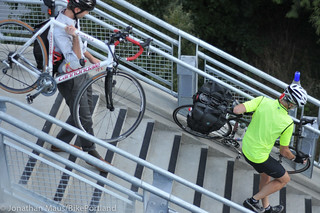On the eastern end of the new (and carfree) Gibbs Street Bridge over I-5, there are two options: You can either carry/push your bike up or down the many flights of stairs, or you can wait for the elevator. When the elevator is not working — which has been the case four times since the bridge opened in July — you are left with only one option. And, as I noted earlier this month, the stairs can be challenging if you have a bike.
This morning, the City of Portland announced yet another closure of the elevator. This would be the fifth closure in just two months. Is this elevator unreliable? Is it time to improve the stairs to make them easier to navigate with a bike in-arms?
According to PBOT spokesperson Dan Anderson, only one of the five elevators closures was due to needed repairs. Three of them were for routine maintenance of a new elevator, and the upcoming closure (which could last up to two weeks starting tomorrow) is for a state inspection required for the bridge to get final permitting approval.
Anderson says PBOT wanted to open the bridge as soon as possible, so they have been operating the elevator under temporary permits.
While it’s comforting to know that the closures thus far aren’t reason to think the elevator is unreliable, it does make me think about the quality of the stairway option. At the moment, the wheel gutter is a narrow strip (just a few inches wide) of flat pavement tucked under the railing at one edge of the stairway. Using the gutter isn’t as easy as it should be, especially if you are carrying groceries, kids, have a cargo bike, and so on.
I’ve heard from PBOT staff that they are considering a project to improve wheel gutter. The question is: Should PBOT spend time and money to make the wheel gutter easier to use? (Hint: They will not do the project unless they get more public pressure to do so.)
Ideally, this (and all other bridges built for bike access) would come with ramps; but a long bicycle ramp (which could be used by wheelchair users as well) adds considerable cost to a project. We saw how this played out on the Waud Bluff Trail design, where there’s no elevator option at all and people on bikes will be forced to walk their bikes (due to steepness) and carry their bikes up/down the stairs.
This bridge/stair access issue is an important one to think about when we design for bicycle users. Should we be building new bridges — especially ones built specifically to promote active transportation — that require people to carry their bicycles down many flights of stairs? Would we ever build something that requires people to get out of their cars and push them? What would Copenhagen do? Or, should we just be grateful we have any bike access at all?
——
UPDATE: I found a few photos of how wheel gutters are done in Europe. The images below are from Amsterdam and Frankfurt and they were taken from a presentation of bike facilities given by PBOT traffic engineer Rob Burchfield following a European trip a few years ago.
Amsterdam…

Frankfurt…

Both of these designs are significantly better than what we currently have at Gibbs.



